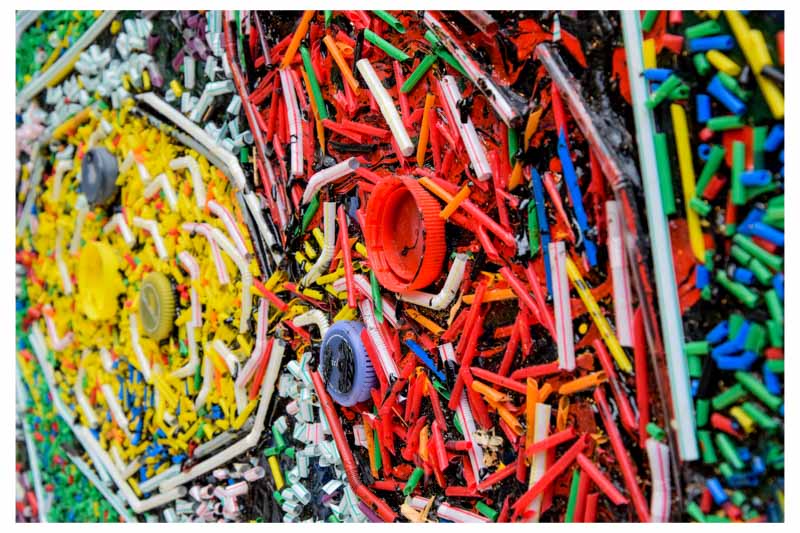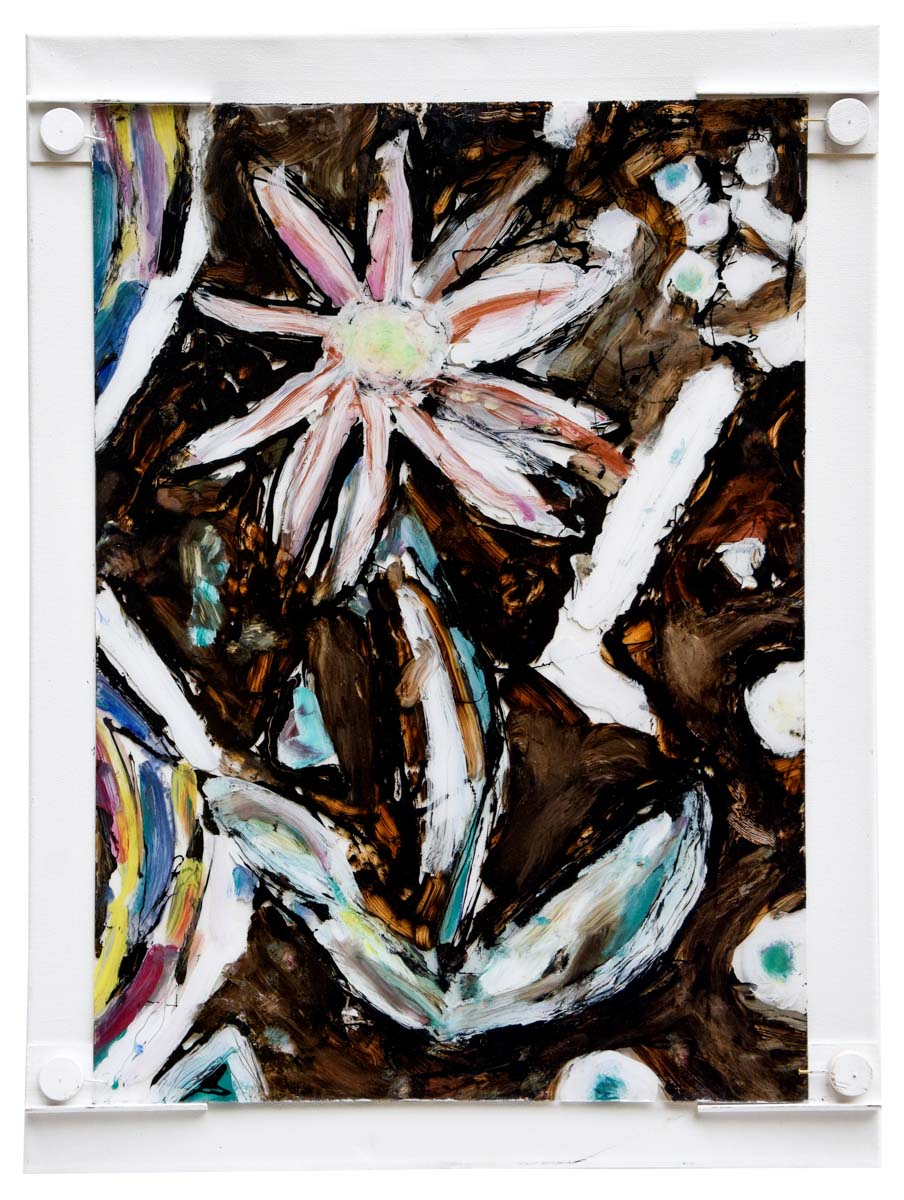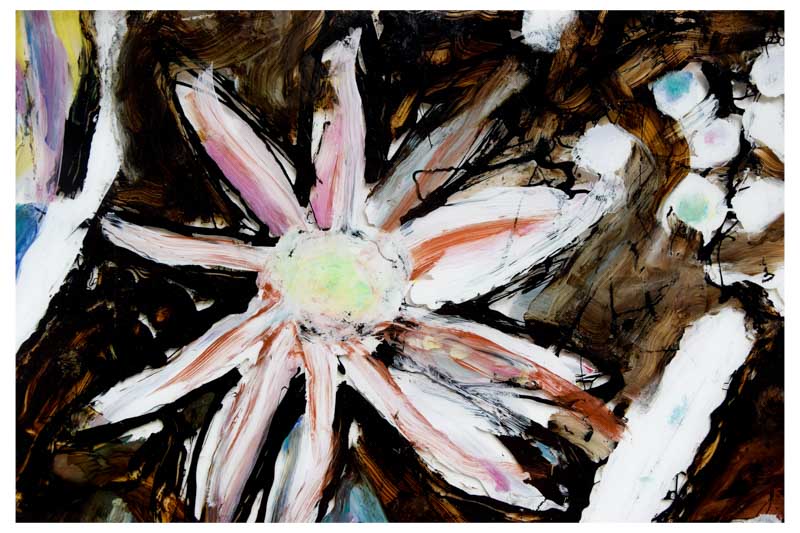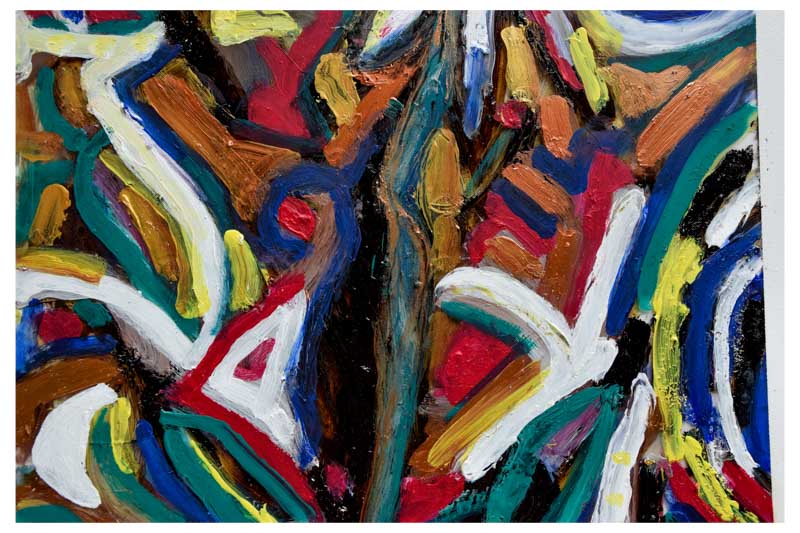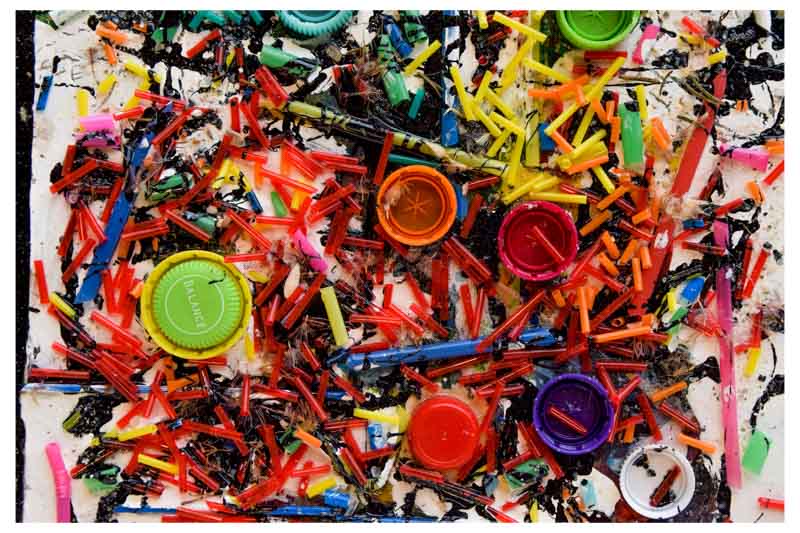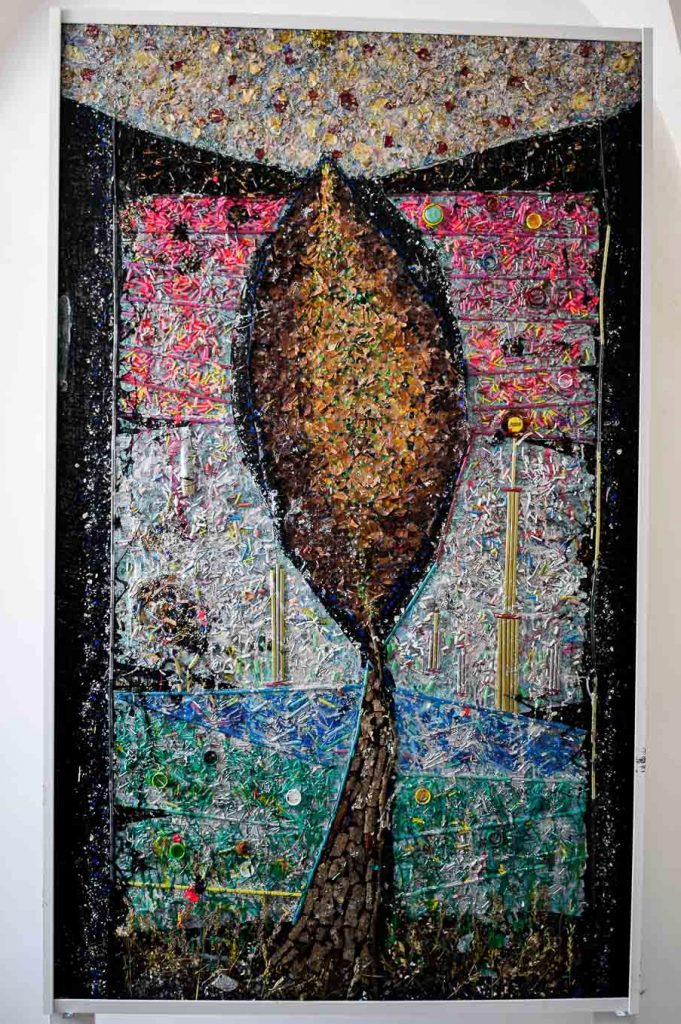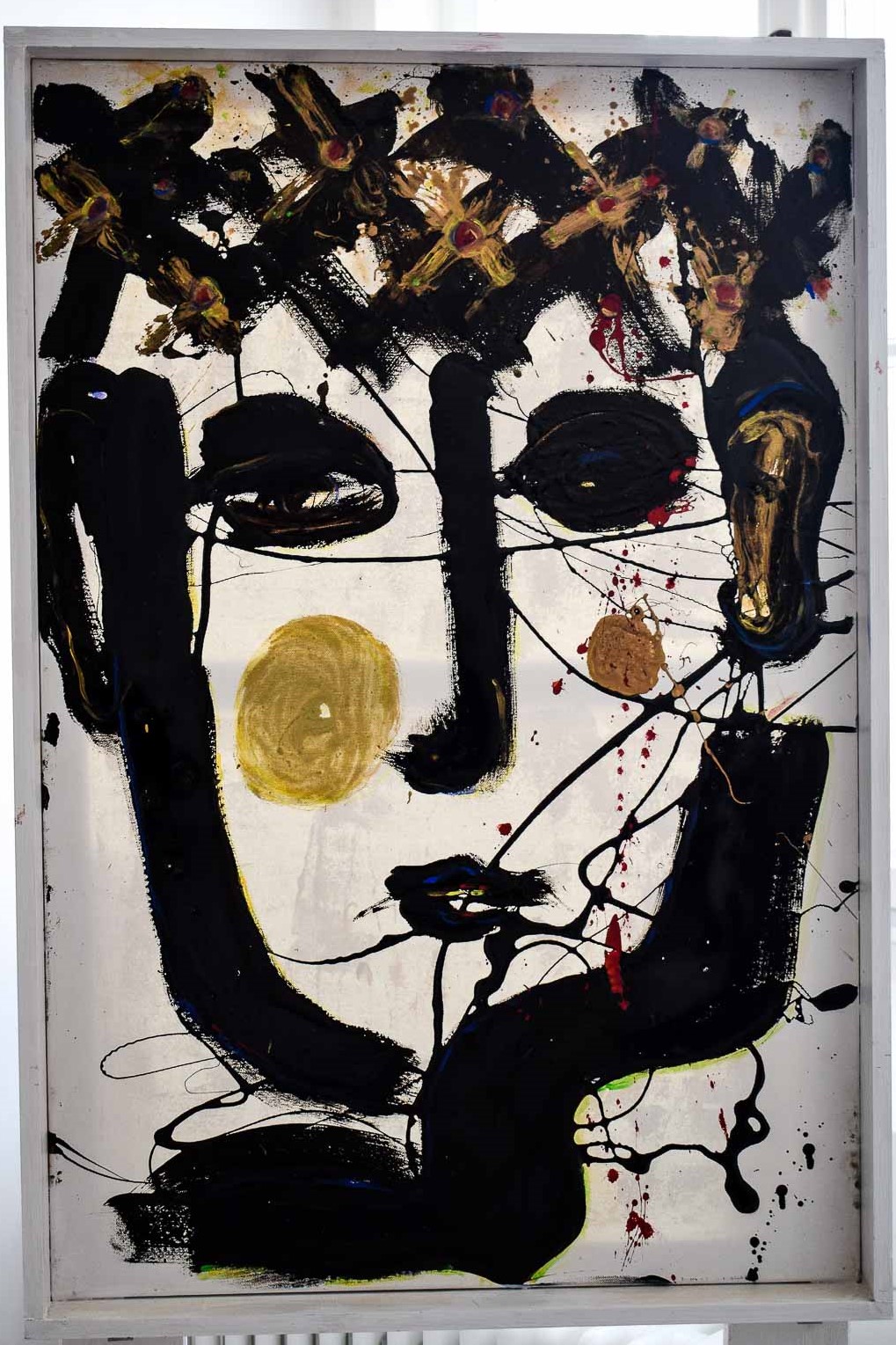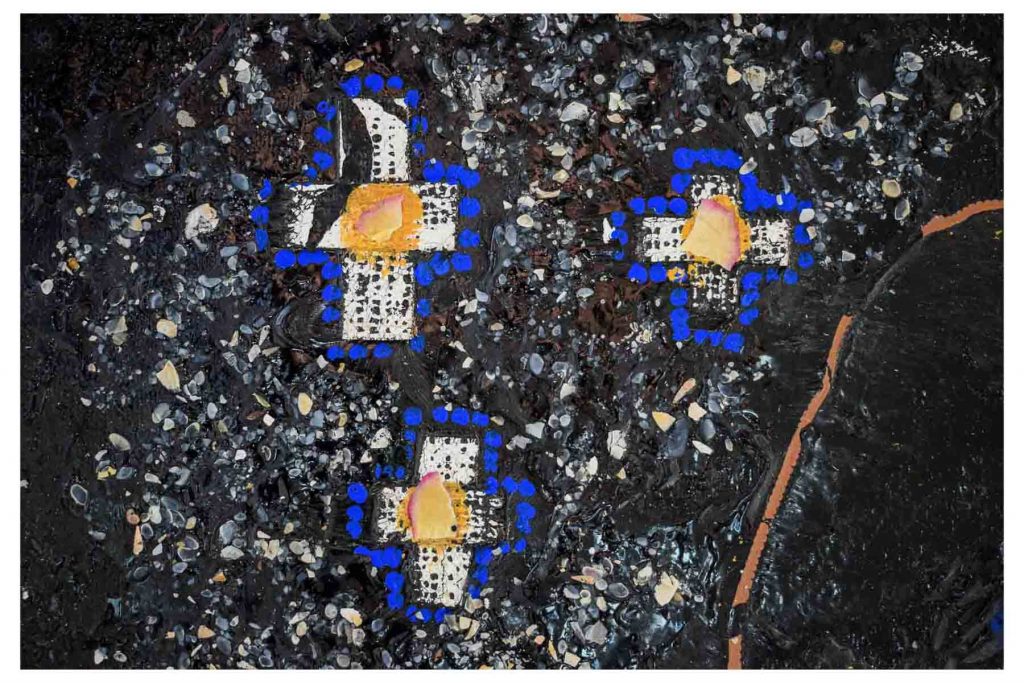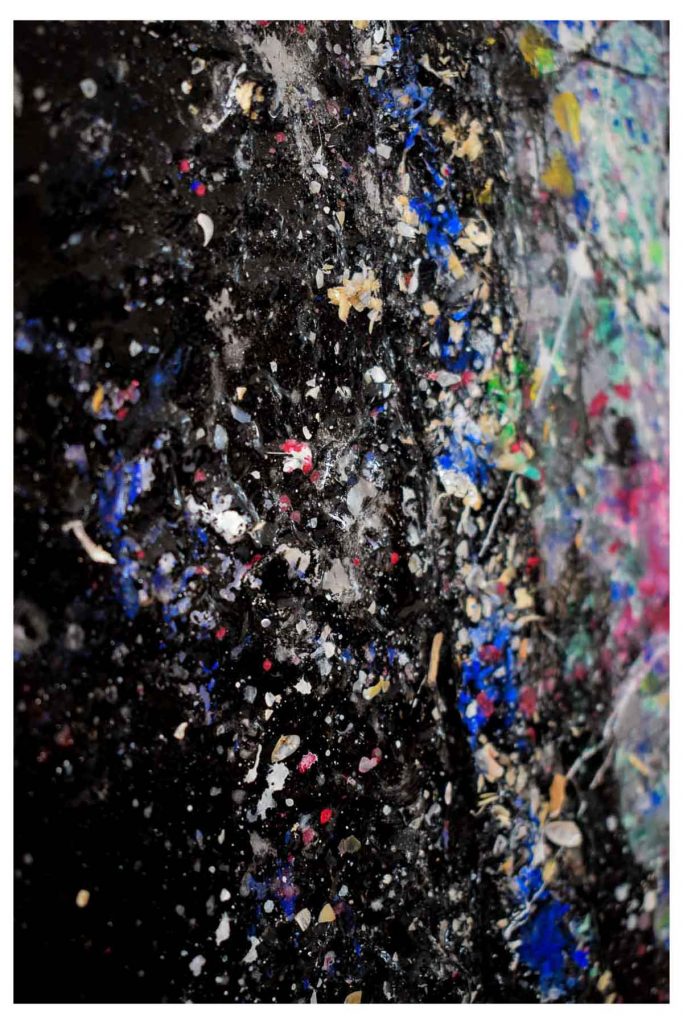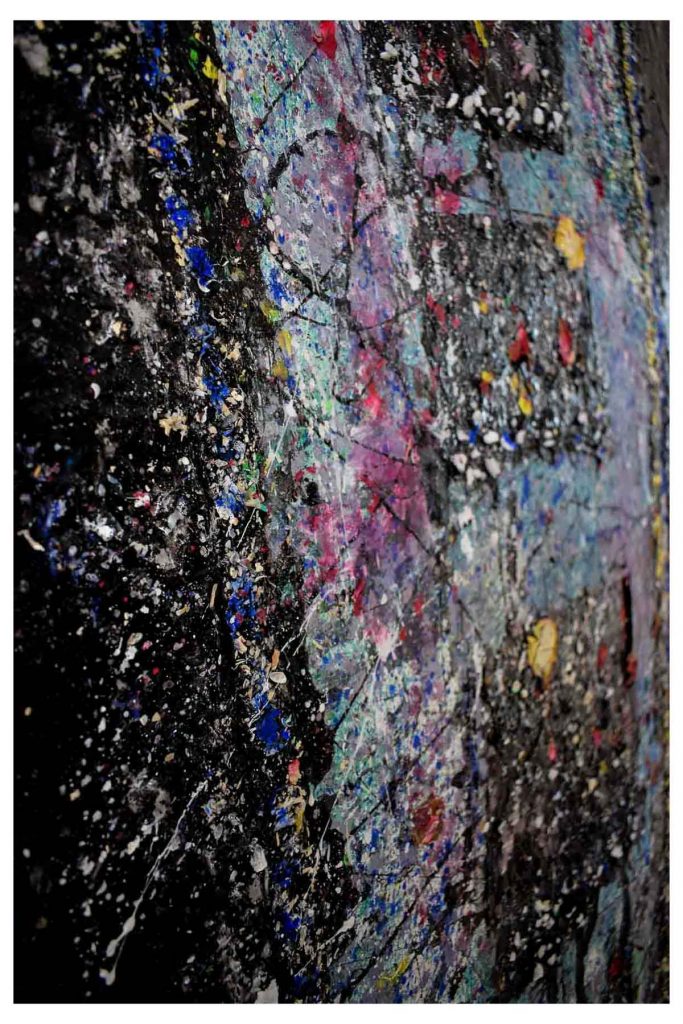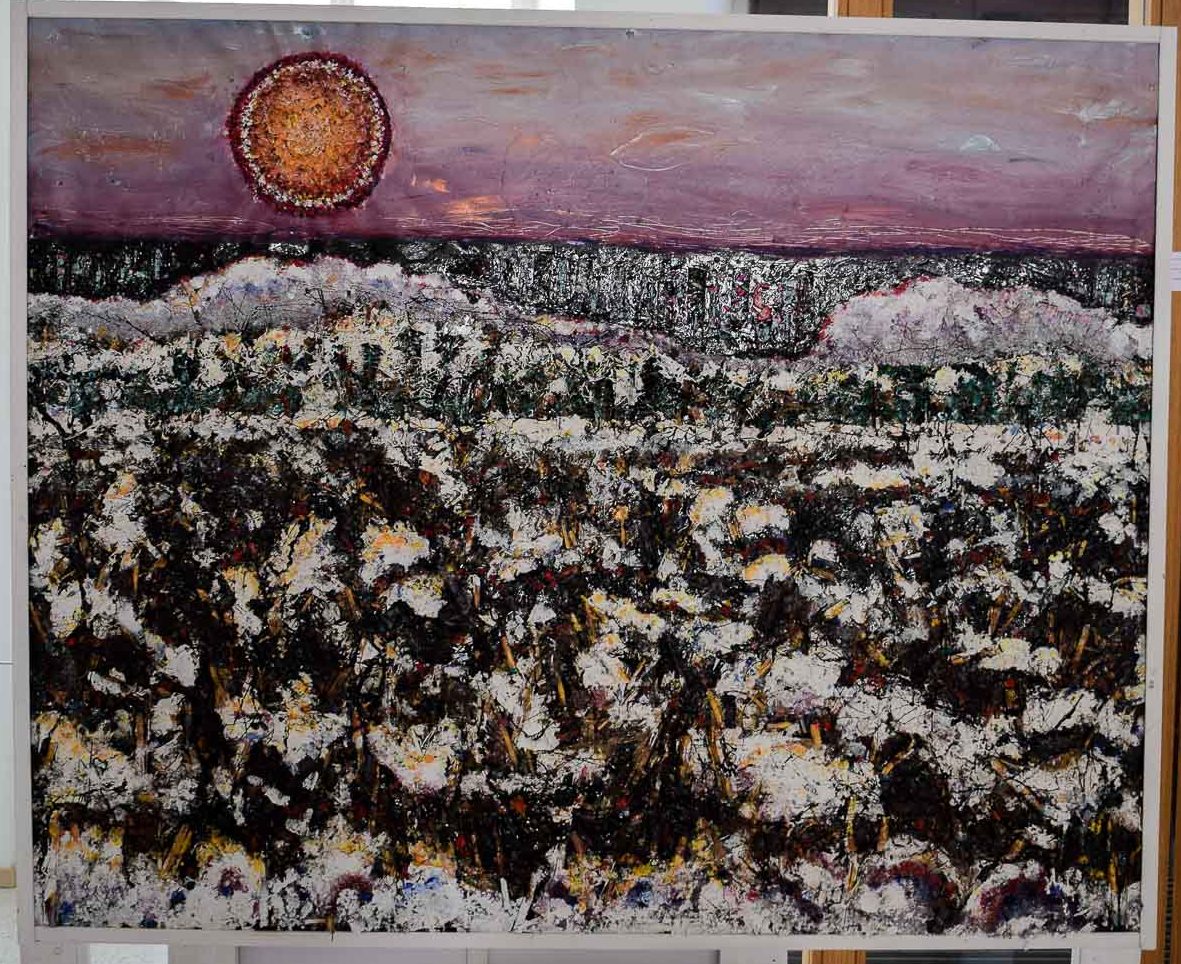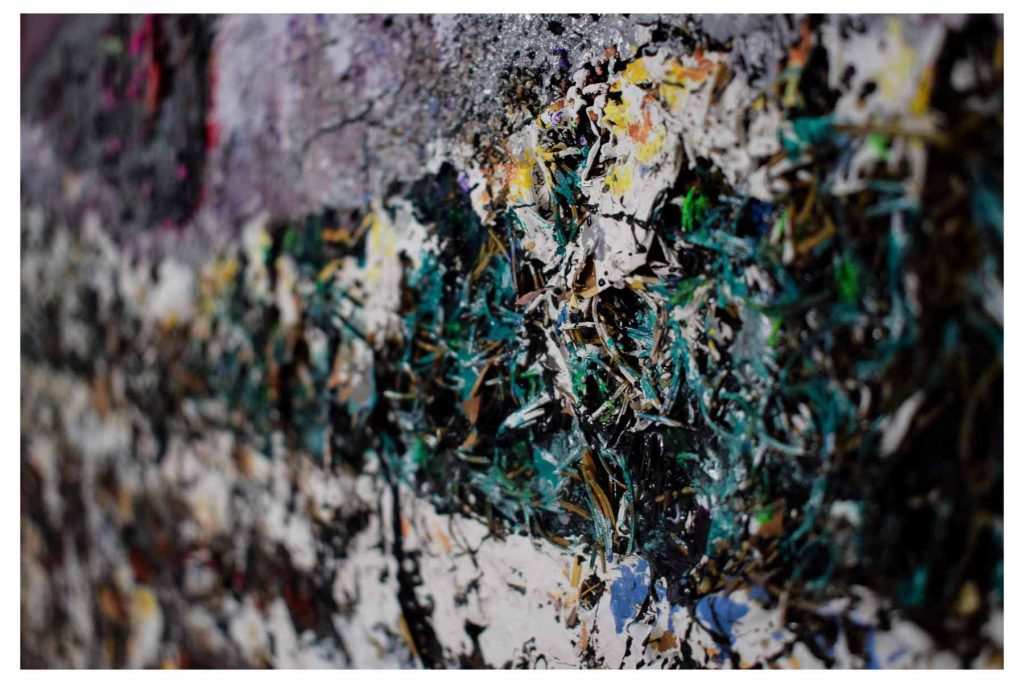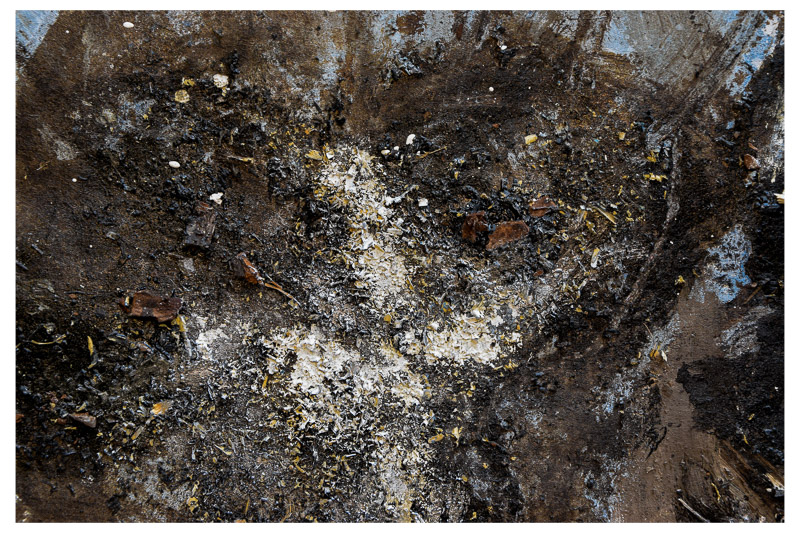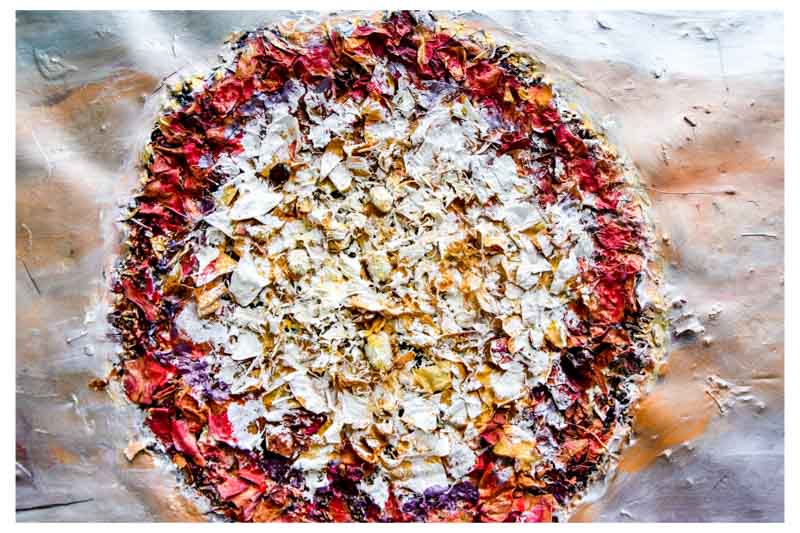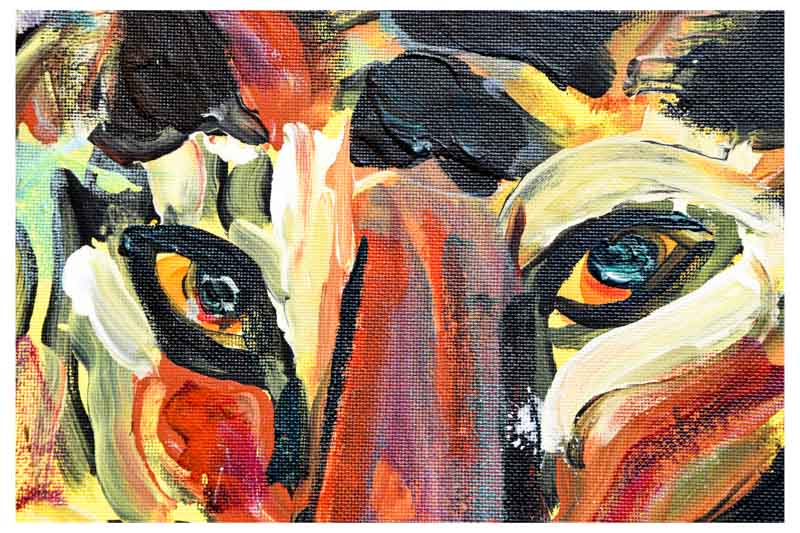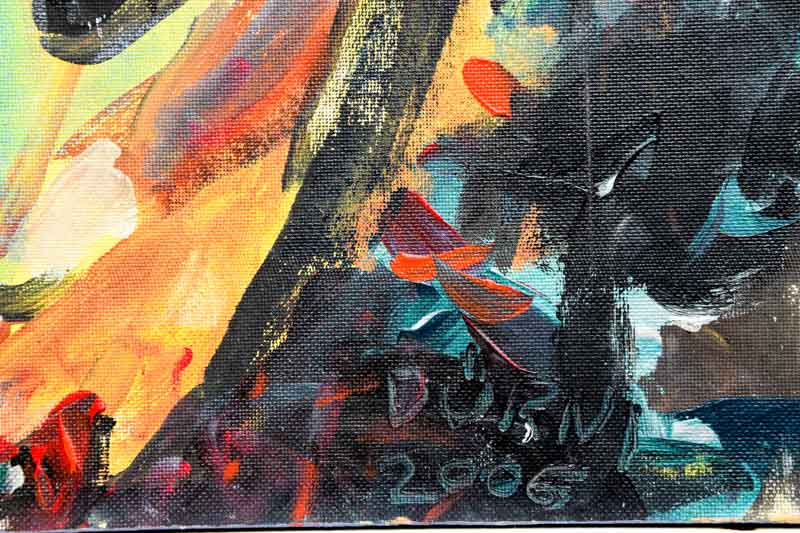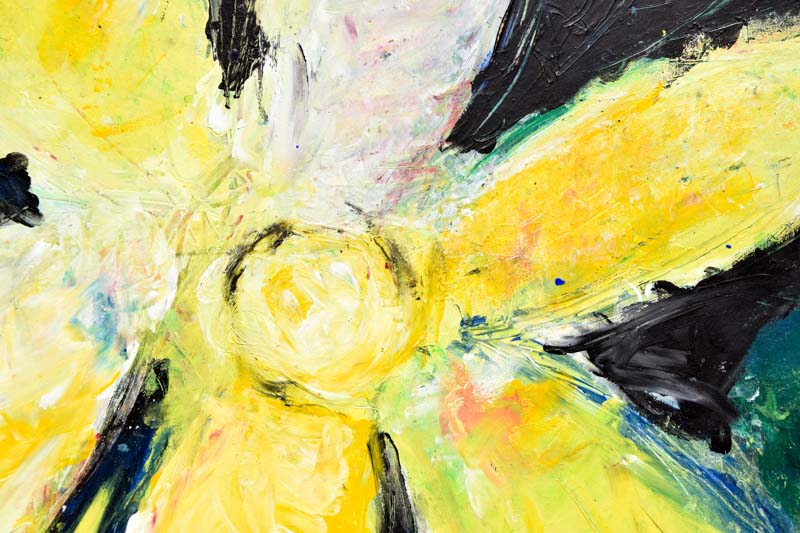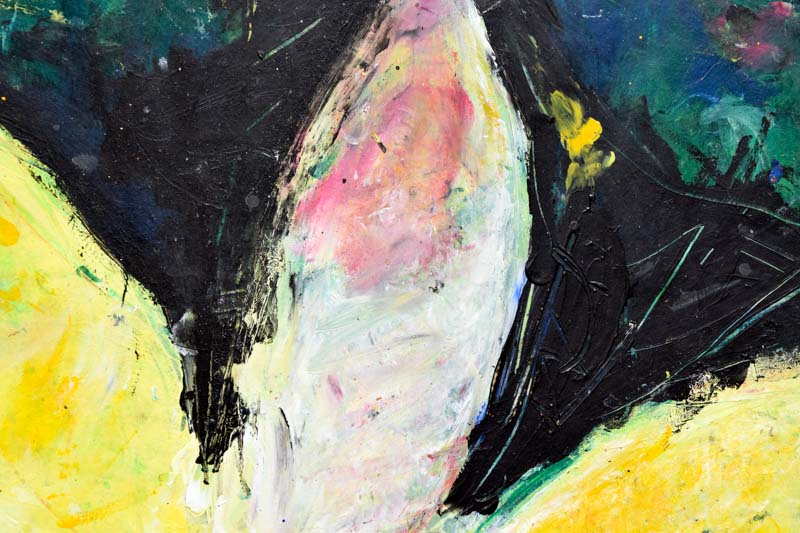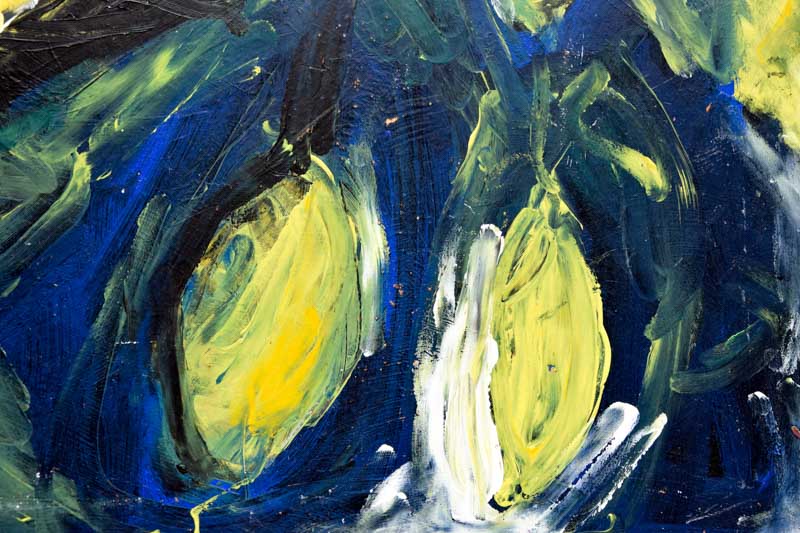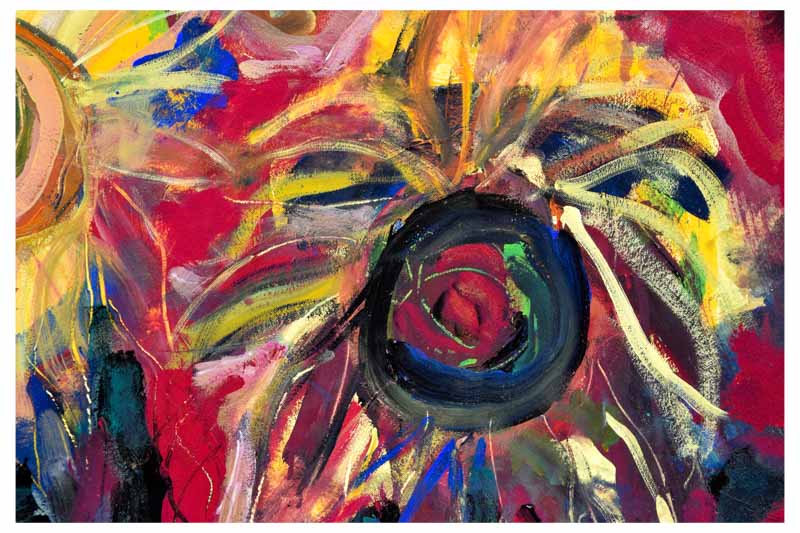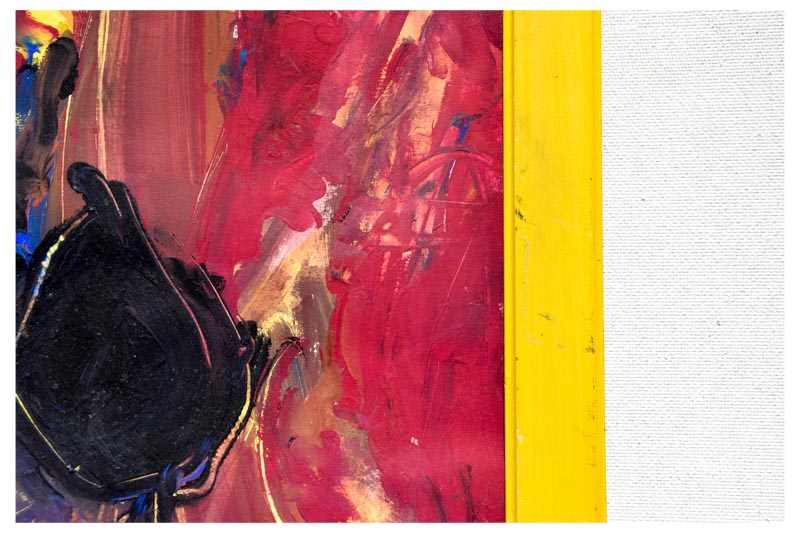MATERIALS
Bitumen
As a product of petroleum, the bitumen has a dark-colored, semi-solid, meltable structure. Its form is very close to that of the crude oil itself, so it naturally acts as a reference to this primal substance. Today we mainly find the material in asphalt, which is used in road construction and in various products for sealing purposes. Crude oil, or bitumen, is a primal substance of Mother Nature and possesses a green essence, the life energy of millions of years and is available to man as a gift. The archaic, absolute blackness sometimes literally reflects the mysterious solemnity and the unfathomable weight of being before the eyes of the viewer. In Franz Dürnberger’s work, bitumen is probably the most succinct material, a kind of invocation of vivid black from the depths of being.
Wood, leaves, grass
Wood, in the form of chips and pieces of bark, are often included in the pictures, but also other components of the tree, such as leaves or needles. Symbolically, wood stands for a way of life in harmony with nature, in a distinctly harsh, but also healthy form. In this context, wood stands for simplicity, warming energy and security, but all without sentimentality.
In addition to the leaves of trees, flower blossoms or flower petals are also used, both often in direct connection with analog colors, as a result of which the latter experience a kind of “materialization”. Rose petals, for example, stand for love, or also express the longing for love in its abundance. Lighter shades of cherry and apple blossoms represent tenderness and blooming. Glowing dandelion heads represent irrepressible power, are symbols for the divine origin of creation, including grass green, albeit in a milder manner.
Shell and stone chips
Shell chips arise from the shell remains of dead mollusks. Their lime shells are applied in the art. The material (it comes from beaches along the upper Adriatic) is mostly used in the form of chippings, on the one hand so as not to appear too decorative, on the other hand smaller shells are rather fragile in their shape anyway; and it is intended that this demonstrated in the background. In the occidental religious tradition since the Middle Ages, the mussel has been a symbol of spiritual pilgrimage (“scallop shell”), speaking to the personal experience of being repeatedly broken, i.e. personal wounds and scars, appearing like a featureless “face”, without knowledge of “the disease”, and no possibility of healing. But the shell is also the place of hidden, inner beauty (such as “pearls!”) and a symbol of the purified, healthy soul, the shine of which is at last revealed. In the works of Franz Dürnberger, it represents the longing for salvation and wholeness that shapes and moves everyone.
The stone chips used in the pictures mainly consist of two types of rock: granite and calcite. Granites are massive and relatively coarse-crystalline igneous, deep rocks that are rich in quartz and feldspar, but also contain dark minerals, especially mica. They stans for strength, reliability, loyalty and protection. The white radiant calcite is a very common mineral of the carbonates and develops different crystal and aggregate forms. It is a sign of perfection as an ultimately religious expectation: “Christ – hope for glory”, as is written in a letter from the Apostle Paul. It is connected with the conviction of the resurrection of the human person from death and the transformation of all creation, centered in the person of Jesus Christ, the powerful glow of light from his resurrection.
Plastic
Plastic is like bitumen, but is a petroleum product that is transformed completely differently; both are often combined in the artist’s works. The formless bitumen base becomes a reference back to the starting point, to the origin of the plastic, which is often only scattered in the form of particles.
This connection and cycle appears inconceivable and mostly remains out of view. And indeed, plastic appears as a material, in comparison to forms made of wood, stone, metal, but also to crude oil itself, so incredibly far from its source, and appears almost like “nature-less”. In addition, plastic, the substance that can take any shape and color, is solid but completely transparent, hard as it is soft – actually a magic of human creativity.
Without denying these fascinating aspects – or wanting to diminish the importance of this material – plastic in Franz Dürnberger’s works, precisely because it is almost “nature-free”, often becomes a point of reference for cultural criticism. As the “last substance” of human-possible transformation of nature – or so the artist is convinced – plastic also carries the sense of a “final humanity”; that is, it offers up this aesthetic sign. It is that of the secular “western world” which – despite all the practical “lightness of being” in the course of general technological welfare and the “disposal” of many moral “legacies” – now finds itself to be completely relativized. In general, “rootless” as well as “godless” in its mentality, it is a humanity to which heaven and earth have become meaningless in the same way, when it comes to finding meaning and orientation, which goes beyond the current world reality and human arbitrariness . What remains to the “senseless” individual is the escape (whether cozy or combative, whether with or without ideology) from his temporarlity, into an illusion of a stable lightness and colourfulness of life, expressed allegorically, in a world, free from suffering, as if made of plastic.
In the series of images with the enigmatic letter combination “bclimtp”, plastic material, especially in contrast to natural material, reveals its high-gloss seductive charm, suggesting a constant, light, almost floating state. And yet: the presence of natural material, in its grounded, grown, multifaceted, often delicately fragile appearance, on closer inspection reveals plastic, which is also sterile and uniform, as a medium of illusion. Incidentally, “bc lim tp” is an abbreviation for the following message: “Be careful, life is more than plastic!
But plastic can also act differently in its materiality – and fabrics are often very dialectical in their symbolism – as the artist shows. In striking works with the subtitle “Playing Plastic”, the quasi-superficial lightness and colorfulness of the material then becomes a positive medium, of a purposeless playfulness that does not serve to escape and remain in illusions, but that, as with a truly carefree game, transcends the spirituality of the world human person revealed. For the artist, such purposeless, creative “machinations” can be found most obviously where ideology least limits the imagination, namely: at the level of the children and their creativity.
For Franz Dürnberger – who is himself is the father of a large family and as such became a passionate collector of hundreds of children’s drawings – children’s drawings are a fascinating source of inspiration. Children’s drawings have often (and certainly will continue to be) been used to create pictures. Thematic areas develop from this (eg: “cars / cars”, “flowers / streetflowers”), ideas are taken up, copied and enriched, or redesigned. The shine, colourfulness and lightness of plastic, the preferred material for image design, seem ideal to the artist. “Playing Plastic” – “there the child shows (also) in the man”. More information can be found in “TEXT” under “Playing Plastic – a kind of dialogue with the subject”
Finally and perhaps even more important: especially in the area of religious motifs, plastic even functions as a medium for the “incarnation of divine messages” – in the quasi-banal, contemporary appearance it conveys. This is particularly pronounced in the so-called “Blue Plastic – Works”, where plastic material, more precisely fragments of drinking water bottles and their caps, but above all fragments of drinking straws, becomes an aesthetic springboard, for example, about the “thirst for life”, and for spiritual thought about the senses and the perception of Christ as “life-giving water” in a work like “Blue Plastic Christ”. More about this can be read in the “TEXT” found under “Blue Plastic Christ”.



